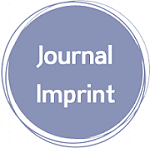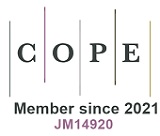Non-mass Enhancement in Breast MRI: Characterization with BI-RADS Descriptors and ADC Values
Downloads
Objectives: The purpose of this study was to assess the accuracy of contrast-enhanced magnetic resonance imaging and diffusion-weighted imaging in distinguishing benign from malignant non-mass-like breast lesions. Methods: 103 lesions showing non-mass-like enhancement in 100 consecutive patients were analyzed. Distribution, internal enhancement patterns, and contrast kinetic curve patterns were classified according to the BI-RADS lexicon. Apparent diffusion coefficient (ADC) values were obtained from manually placed regions of interest (ROIs) on diffusion-weighted images. The optimal ADC value threshold for the distinction between benign and malignant lesions was determined by ROC analysis. Univariate and multivariate analyses were performed to identify independent predictors of malignancy, and the probability of malignancy was calculated for various combinations of findings. Histological diagnosis obtained by means of core needle biopsy was used as gold standard. Results: According to the univariate and multivariate analysis, odds ratios for malignancy were significantly elevated for clumped or clustered ring internal enhancement and low ADC values (p < 0.001), whereas distribution patterns and contrast kinetic patterns were not significantly correlated with benignity or malignancy. In non-mass lesions with homogeneous or heterogeneous internal enhancement and ADC values greater than 1.26×10-3mm2/s, no malignancy was detected, while all other combinations of findings had a probability of malignancy ranging from 22.2 to 76.6%. Conclusions: A combination of BI-RADS descriptors of internal enhancement and ADC values is useful for the differential diagnosis of lesions showing non-mass enhancement. Lesions with homogeneous or heterogeneous enhancement and high ADC can be followed up, while all other lesions should be biopsied.
Doi:10.28991/SciMedJ-2021-0302-1
Full Text:PDF
Downloads
Morrow, M., Waters, J., & Morris, E. (2011). MRI for breast cancer screening, diagnosis, and treatment. The Lancet, 378(9805), 1804–1811. doi:10.1016/s0140-6736(11)61350-0.
Sardanelli, F., Boetes, C., Borisch, B., Decker, T., Federico, M., Gilbert, F. J., … Wilson, R. (2010). Magnetic resonance imaging of the breast: Recommendations from the EUSOMA working group. European Journal of Cancer, 46(8), 1296–1316. doi:10.1016/j.ejca.2010.02.015.
Morris, E. A. (2007). Diagnostic Breast MR Imaging: Current Status and Future Directions. Radiologic Clinics of North America, 45(5), 863–880. doi:10.1016/j.rcl.2007.07.002.
Millet, I., Pages, E., Hoa, D., Merigeaud, S., Curros Doyon, F., Prat, X., & Taourel, P. (2012). Pearls and pitfalls in breast MRI. The British Journal of Radiology, 85(1011), 197–207. doi:10.1259/bjr/47213729.
Phi, X.-A., Houssami, N., Hooning, M. J., Riedl, C. C., Leach, M. O., Sardanelli, F., … de Bock, G. H. (2017). Accuracy of screening women at familial risk of breast cancer without a known gene mutation: Individual patient data meta-analysis. European Journal of Cancer, 85, 31–38. doi:10.1016/j.ejca.2017.07.055.
Morris, E.A., Comstock, C.E., Lee, C.H. (2013). ACR BI-RADS Magnetic Resonance Imaging, in: D´Orsi, C.J., Sickles, E.A., Mendelson, E.B., Morris, E.A. (eds.). ACR BI-RADS Atlas, Breast Imaging Reporting and Data System. Reston, VA, American College of Radiology.
Mahoney, M. C., Gatsonis, C., Hanna, L., DeMartini, W. B., & Lehman, C. (2012). Positive Predictive Value of BI-RADS MR Imaging. Radiology, 264(1), 51–58. doi:10.1148/radiol.12110619.
Ballesio, L., Di Pastena, F., Gigli, S., D’Ambrosio, I., Aceti, A., Pontico, M., Manganaro, L., Porfiri, L.M., Tardioli, S. (2014). Non mass-like enhancement categories detected by breast MRI and histological findings. Eur Rev Med Pharmalcol Sci 18, 910-917. PMID: 24706319.
Shao, Z., Wang, H., Li, X., Liu, P., Zhang, S., & Cao, S. (2013). Morphological Distribution and Internal Enhancement Architecture of Contrast-Enhanced Magnetic Resonance Imaging in the Diagnosis of Non-Mass-Like Breast Lesions: A Meta-Analysis. The Breast Journal, 19(3), 259–268. doi:10.1111/tbj.12101.
Wilhelm, A., McDonough, M. D., & DePeri, E. R. (2012). Malignancy Rates of Non-masslike Enhancement on Breast Magnetic Resonance Imaging Using American College of Radiology Breast Imaging Reporting and Data System Descriptors. The Breast Journal, 18(6), 523–526. doi:10.1111/tbj.12008.
Bartella, L., Liberman, L., Morris, E. A., & Dershaw, D. D. (2006). Nonpalpable Mammographically Occult Invasive Breast Cancers Detected by MRI. American Journal of Roentgenology, 186(3), 865–870. doi:10.2214/ajr.04.1777.
Baltzer, P. A. T., Benndorf, M., Dietzel, M., Gajda, M., Runnebaum, I. B., & Kaiser, W. A. (2010). False-Positive Findings at Contrast-Enhanced Breast MRI: A BI-RADS Descriptor Study. American Journal of Roentgenology, 194(6), 1658–1663. doi:10.2214/ajr.09.3486.
El Khoury, M., Lalonde, L., David, J., Labelle, M., Mesurolle, B., & Trop, I. (2015). Breast imaging reporting and data system (BI-RADS) lexicon for breast MRI: Interobserver variability in the description and assignment of BI-RADS category. European Journal of Radiology, 84(1), 71–76. doi:10.1016/j.ejrad.2014.10.003.
Gutierrez, R. L., DeMartini, W. B., Eby, P. R., Kurland, B. F., Peacock, S., & Lehman, C. D. (2009). BI-RADS Lesion Characteristics Predict Likelihood of Malignancy in Breast MRI for Masses But Not for Nonmasslike Enhancement. American Journal of Roentgenology, 193(4), 994–1000. doi:10.2214/ajr.08.1983.
Kul, S., Eyuboglu, I., Cansu, A., & Alhan, E. (2013). Diagnostic efficacy of the diffusion weighted imaging in the characterization of different types of breast lesions. Journal of Magnetic Resonance Imaging, 40(5), 1158–1164. doi:10.1002/jmri.24491
Imamura, T., Isomoto, I., Sueyoshi, E., Yano, H., Uga, T., Abe, K., … Uetani, M. (2010). Diagnostic Performance of ADC for Non-mass-like Breast Lesions on MR Imaging. Magnetic Resonance in Medical Sciences, 9(4), 217–225. doi:10.2463/mrms.9.217.
Partridge, S. C., Mullins, C. D., Kurland, B. F., Allain, M. D., DeMartini, W. B., Eby, P. R., & Lehman, C. D. (2010). Apparent Diffusion Coefficient Values for Discriminating Benign and Malignant Breast MRI Lesions: Effects of Lesion Type and Size. American Journal of Roentgenology, 194(6), 1664–1673. doi:10.2214/ajr.09.3534.
Yabuuchi, H., Matsuo, Y., Kamitani, T., Setoguchi, T., Okafuji, T., Soeda, H., … Honda, H. (2010). Non-mass-like enhancement on contrast-enhanced breast MR imaging: Lesion characterization using combination of dynamic contrast-enhanced and diffusion-weighted MR images. European Journal of Radiology, 75(1), e126–e132. doi:10.1016/j.ejrad.2009.09.013.
Liberman, L., Morris, E. A., Lee, M. J.-Y., Kaplan, J. B., LaTrenta, L. R., Menell, J. H., … Dershaw, D. D. (2002). Breast Lesions Detected on MR Imaging: Features and Positive Predictive Value. American Journal of Roentgenology, 179(1), 171–178. doi:10.2214/ajr.179.1.1790171.
Tozaki, M., & Fukuda, K. (2006). High-Spatial-Resolution MRI of Non-Masslike Breast Lesions: Interpretation Model Based on BI-RADS MRI Descriptors. American Journal of Roentgenology, 187(2), 330–337. doi:10.2214/ajr.05.0998.
Chikarmane, S. A., Michaels, A. Y., & Giess, C. S. (2017). Revisiting Nonmass Enhancement in Breast MRI: Analysis of Outcomes and Follow-Up Using the Updated BI-RADS Atlas. American Journal of Roentgenology, 209(5), 1178–1184. doi:10.2214/ajr.17.18086.
Uematsu, T., & Kasami, M. (2012). High-Spatial-Resolution 3-T Breast MRI of Nonmasslike Enhancement Lesions: An Analysis of Their Features as Significant Predictors of Malignancy. American Journal of Roentgenology, 198(5), 1223–1230. doi:10.2214/ajr.11.7350.
Sakamoto, N., Tozaki, M., Higa, K., Tsunoda, Y., Ogawa, T., Abe, S., … Fukuma, E. (2008). Categorization of non-mass-like breast lesions detected by MRI. Breast Cancer, 15(3), 241–246. doi:10.1007/s12282-007-0028-6.
Tozaki, M., Igarashi, T., & Fukuda, K. (2006). Breast MRI Using the VIBE Sequence: Clustered Ring Enhancement in the Differential Diagnosis of Lesions Showing Non-Masslike Enhancement. American Journal of Roentgenology, 187(2), 313–321. doi:10.2214/ajr.05.0881.
Grimm, L. J., Anderson, A. L., Baker, J. A., Johnson, K. S., Walsh, R., Yoon, S. C., & Ghate, S. V. (2015). Interobserver Variability Between Breast Imagers Using the Fifth Edition of the BI-RADS MRI Lexicon. American Journal of Roentgenology, 204(5), 1120–1124. doi:10.2214/ajr.14.13047.
Chen, X., Li, W., Zhang, Y., Wu, Q., Guo, Y., & Bai, Z. (2010). Meta-analysis of quantitative diffusion-weighted MR imaging in the differential diagnosis of breast lesions. BMC Cancer, 10(1). doi:10.1186/1471-2407-10-693.
Bickel, H., Pinker, K., Polanec, S., Magometschnigg, H., Wengert, G., Spick, C., … Baltzer, P. (2016). Diffusion-weighted imaging of breast lesions: Region-of-interest placement and different ADC parameters influence apparent diffusion coefficient values. European Radiology, 27(5), 1883–1892. doi:10.1007/s00330-016-4564-3.
Arponent, O., Sudah, M., Masarwah, A., Taina, M., Rautiainen, S., Könönen, M., Sironen, R., Kosma, V.M., Sutela, A., Hakumäki, J., Vanninen, R. (2015). Correction: Diffusion-Weighted Imaging in 3.0 Tesla Breast MRI: Diagnostic Performance and Tumor Characterization Using Small Subregions vs. Whole Tumor Regions of Interest. PLOS ONE, 10(10), e0141833. doi:10.1371/journal.pone.0141833.
Min, Q., Shao, K., Zhai, L., Liu, W., Zhu, C., Yuan, L., & Yang, J. (2015). Differential diagnosis of benign and malignant breast masses using diffusion-weighted magnetic resonance imaging. World Journal of Surgical Oncology, 13(1), 32. doi:10.1186/s12957-014-0431-3.
Bogner, W., Pinker-Domenig, K., Bickel, H., Chmelik, M., Weber, M., Helbich, T. H., … Gruber, S. (2012). Readout-segmented Echo-planar Imaging Improves the Diagnostic Performance of Diffusion-weighted MR Breast Examinations at 3.0 T. Radiology, 263(1), 64–76. doi:10.1148/radiol.12111494.
Nogueira, L., Brandão, S., Matos, E., Nunes, R. G., Ferreira, H. A., Loureiro, J., & Ramos, I. (2015). Region of interest demarcation for quantification of the apparent diffusion coefficient in breast lesions and its interobserver variability. Diagnostic and Interventional Radiology, 21(2), 123–127. doi:10.5152/dir.2014.14217.
- This work (including HTML and PDF Files) is licensed under a Creative Commons Attribution 4.0 International License.












